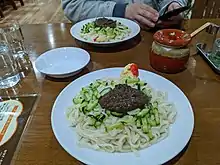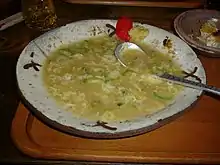Morioka Jajamen
Morioka Jajamen (盛岡じゃじゃ麺) is a Japanese-style Chinese noodle dish that is part of the local cuisine of Morioka, Iwate Prefecture. It is one of the Three Great Noodles of Morioka, along with Morioka Reimen and Wanko soba. The dish is based on Zhajiangmian introduced from China.
 | |
| Place of origin | China (origin) Morioka, Iwate Prefecture (adaptation) |
|---|---|
| Region or state | East Asia |
| Associated cuisine | Japanese |
| Created by | Takashina Kanshou |
| Variations | Jajangmyeon, Zhajiangmian |
History
Before World War II Takashina Kanshou (高階貫勝) visited Manchukuo, now Northeast China, and ate Zhajiangmian. In 1945 he returned to his hometown in Morioka and brought the dish with him. He recreated the miso paste many times on his return and incorporated the opinions of his customers to create a taste that was popular with the locals of Morioka. It eventually evolved into its own unique dish that is now a specialty of Morioka with many restaurants and izakayas offering it.[1][2][3]
Overview
Morioka Jajamen uses a thin udon noodle. It is served with a scoop of meat miso which is a combination of minced pork, onion, dried shitake mushrooms, water, vegetable oil, sake, garlic, ginger, miso, mentsuyu, sugar, black ground sesame, and sesame oil. It is then garnished with cucumber, spring onions, and ginger. After mixing the dish vinegar, chilli oil, or garlic can be added to taste.[4][5]
 Before Mixing
Before Mixing After Mixing
After Mixing
Chitantan

Near the completion of the dish, the eater may decide to turn it into Chitantan (Japanese: チータンタン). With the remaining sauce and a few noodles, a raw egg is cracked into the bowl. Boiling water is added to cook the egg and mix with the remaining sauce. Additional meat miso or condiments can be added to taste.[6][7][8]
The term Chitantan comes from the Chinese: 雞蛋湯; pinyin: jīdàntāng; "chicken egg soup", but in Japanese: 鶏蛋湯; rōmaji: Chītantan the pronunciation changes to meet Japanese phonology, but the kanji is not used and is instead written in katakana for foreign imported words.[9] For more information see Sino-Japanese vocabulary.
Zhajiangmian
Zhajiangmian (traditional Chinese: 炸醬麵; simplified Chinese: 炸酱面; pinyin: zhájiàngmiàn; "fried sauce noodles") is the inspiration for Morioka Jajamen, but has many differences. While Morioka Jajamen is a very uniform dish, zhajiangmian has many varieties. The type of noodles can be varied depending on region.[10] As well the main sauce used differs from the Japanese miso base and instead uses sweet bean sauce.[11][12]
Korea also has their own unique variant of zhajiangmian called Jajangmyeon (자장면).
See also
- Jajangmyeon (Korean variative counterpart of Zhajiangmian)
References
- "じゃじゃ麺の歴史" (in Japanese). Retrieved 22 August 2020.
- Toshiki Tanji. "岩手県の盛岡名物「じゃじゃ麺」発祥の店である、白龍を訪れた!" (in Japanese). Retrieved 22 August 2020.
- "盛岡三大麺のひとつ、じゃじゃ麺" (in Japanese). Retrieved 22 August 2020.
- "あの名店の味を目指せ!盛岡じゃじゃ麺". Cook Pad (in Japanese). Retrieved 22 August 2020.
- "Morioka City Guide". Retrieved 22 August 2020.
- "じゃじゃ麵食堂" (in Japanese). Retrieved 22 August 2020.
- 渡辺智哉. "岩手のじゃじゃ麺 自分で作り出す「最高のおいしさ」". Nikkei Style (in Japanese). Retrieved 22 August 2020.
- "Morioka Jaja-men / Chitantan Soup". tohoku365. 17 September 2016. Retrieved 22 August 2020.
- "盛岡じゃじゃ麺の鶏蛋湯(チータンタン)の意味と食べ方の紹介" (in Japanese). Retrieved 22 August 2020.
- "Zha Jiang Mian—Minced Pork Noodles". China Sichuan Food. Retrieved 22 August 2020.
- "Zha Jiang Mian Fried Sauce Noodles 炸醬麵". The Hong Kong Cookery. Retrieved 22 August 2020.
- Wei. "ZHA JIANG MIAN (炸酱面): BEIJING'S SIGNATURE NOODLES". Red House Spice. Retrieved 22 August 2020.